Cameras add ten pounds, but clothing catalogues shave off twenty with Photoshop. If you’re picturing a "normal" model, you’ve probably got images in your head of a young woman who looks like she only eats three almonds a day. Here’s a surprise: the weight of real-life models is more complicated—and much more diverse—than the stereotype. It’s a question every teenage girl, curious parent (like me), and Netflix-watching skeptic eventually Googles. And the answers change fast, with today’s body positivity era battling decades of harsh industry rules. Let’s lay out what’s actually typical for model weights, where the numbers come from, and why there is no one-size-fits-all in modeling anymore.
Direct Answer: How Much Do Normal Models Weigh?
The average weight of a professional fashion model in 2025 actually falls between 110 and 130 pounds (50-59kg) for women, and between 140 and 170 pounds (64-77kg) for men. Runway models, who are usually taller than average (often 5’9” to 6’ for women), weigh on the lower end of those ranges. Catalog, commercial, and plus-size models span a broader spectrum: female plus-size models regularly range from about 160 to 240 pounds (72-109kg) and are typically size 12 to 22 (US sizing). Fitness models are a world apart, with lower body fat and a much higher ratio of muscle weight, so numbers can look deceiving. But, if you asked a modeling agency for "normal weight," you’d typically get a height-weight ratio showing a body mass index (BMI) between 16 and 20—much lower than the CDC’s healthy range for adults. That’s changing, but slowly.
Key Points: Fast Facts at a Glance
- The average female runway model is 5’9” tall and weighs about 115 pounds (52kg).
- Male models generally stand between 5’11” and 6’2” and weigh from 140 to 170 pounds (64-77kg).
- Plus-size female models range from 160 to 240 pounds (72-109kg), at 5’9” and above.
- Today’s fashion world slowly embraces more body types, but traditional agencies stick to strict numbers for high fashion work.
- Weight alone never tells the whole story—body measurements, muscle mass, and how clothes fit matter more in modeling.

What Does “Normal” Model Weight Mean? Changing Definitions and Real Stories
There’s a myth glued to modeling that "normal" means rail-thin and almost untouchable. This stereotype lives on because high-fashion brands used to chase the waif look hard—and honestly, many still do. Twenty years ago, major designers told agencies to only send girls wearing sample sizes, which were typically a size 2 or even 0, with corresponding weights as low as 105 pounds (48kg) for someone in the 5’9” range. These numbers got splashed all over casting calls and made life miserable for anyone with curves—myself included, in my awkward teenage phase.
But let’s break the numbers down a little more thoughtfully. Today, for runway gigs (think Paris, New York, Milan), most agencies still sign female models with measurements around 34-24-34 inches (bust-waist-hips, in inches), with heights between 5’9” and 6’0”. Weight depends on bone structure, muscles, and genetics, but it averages out to 110-130 pounds (50-59kg). For editorial jobs (magazine shoots), some diversity kicks in: models slightly shorter or with hips or thighs outside that “ideal” range can book work, especially if they’ve got a striking look.
Commercial and catalog modeling open the doors a bit wider. Here, models can range from extra-petite to plus sizes: a "normal" commercial model might be anywhere from a size 2 (for standard women’s wear) to a size 22 (for plus or curve work). That could mean 105 pounds or 240 pounds, depending on body composition and height. Major names like Ashley Graham (5’9”, typically 200 pounds, size 16 US) have flipped the script for mainstream brands, starring in everything from lingerie ads to talk shows. If you flip through your favorite clothing website, you’ll see models representing a whole spectrum of body types, at last.
Another interesting twist: different countries treat ideal weights differently. While French or Italian modeling agencies often stick to strict standards, the UK and parts of America have opened up. For example, London agency MiLK now lists models across a wider size range, and major brands like Nike and Savage X Fenty pose every body type. A recent report from The Fashion Spot showed over 40% of major fall/winter 2025 runways included at least one plus-size or mid-size model—up from only 12% a decade ago.
Where the Numbers Come From: Modeling Categories and Weight Trends
Modeling splits into types, and each comes with its "normal" — which, let’s be honest, means arbitrary—weight targets, mostly handed down from the fashion industry’s top dogs. Here’s what those categories look like:
- Runway models (high fashion): These are the catwalk queens. For women, it’s a classic 5’9"+ height, 34-24-34 inch measurements, 110-130 pounds. Men are 5’11”-6’2”, about 140-170 pounds, but always with a lean frame—six-pack optional, but not required.
- Editorial models: Magazine, print, or campaign work is a little more flexible. If you’ve got a certain face or vibe, you might see waifs and athletes sharing a page, ranging from 110 to 150 pounds for women, but often at least 5’8”.
- Commercial/fitness models: Here weight varies hugely. Fitness models may be compact but dense with muscle (a 5’8” female fitness model can weigh 145 pounds and wear a US size 4), while catalog models are chosen for relatability and may range from size 2 to size 14 (or more). Weight could be anywhere from 110 pounds to 200 pounds, depending on the job.
- Plus-size/curve models: This is where modeling gets way more realistic for the average woman. Runway plus models start size 12 (US)—yes, that’s still "plus" to the industry. Most agencies now list plus models up to size 22, with associated weights between 170 to 240 pounds (77-109kg).
- Parts models: These specialists (for hands, feet, etc.) don’t follow size rules, so their weights reflect the general population more closely.
Children’s modeling is a world apart—think Marcelline and her classmates, with healthy weight-to-height ratios and no brutal measurement restrictions. Kid campaigns finally focus on energy and personality, not numbers on a scale—and thank goodness for that as a mom.
The wild card? For every category, agencies are slowly (oh so slowly) learning that diversity sells. Shifts in public perception, brand pressure, and even government regulations in parts of Europe are forcing agencies to pay attention to health over numbers. France, for instance, requires models to show a medical certificate that they’re not dangerously underweight before taking runway jobs. Still, sample clothing—the pieces that designers send to agencies—come in set sizes, putting the squeeze (literally) on who can get hired for high fashion.

Why the Industry’s Weight Fixation Is Fading
The fashion world has always sold dreams, but for too long, those dreams came in just one size. The grip of the ultra-thin runway model got so intense that by 2015, the backlash was everywhere: from health groups, mental wellness advocates, and parents fed up with unhealthy teen role models. Medical journals started publishing alarming numbers—studies showed aspiring models had double the risk of eating disorders compared to peers, driven by the weight restrictions agencies pushed.
Brands and agencies finally responded (both to protect their image and appeal to broader audiences). Since 2020, top agencies like IMG and Ford have grown curve divisions, and influencers on social media have built massive followings with unapologetically average bodies—think Remi Bader or Paloma Elsesser. Even classic brands, pressured by consumer demand, started featuring a mix of models. Target, Old Navy, and ASOS now regularly shoot campaigns with size-4 and size-24 models (sometimes side-by-side), updating size guides and even using "real customer" try-on images on their sites.
It’s not just PR. Financial reports show that body-diverse advertising literally boosts sales. Clothing stores (both online and off) that feature a variety of bodies see higher engagement across all age groups. And more weight diversity means young people finally see relatable figures wearing the clothes they’re shopping for. My daughter Marcelline, at age 12, can scroll ASOS and find models who actually look like her—tall, a little lanky, but never airbrushed beyond belief. That never happened when I was in school.
Still, for the top tier of high-fashion modeling—the runways of Paris, the covers of Vogue—the focus on specific weights and measurements holds on tight. If you’re dreaming of a career on those catwalks, you won’t escape numbers. The key is that those numbers aren’t "normal" by any real-world standard. They’re part of a manufactured ideal that’s finally, thankfully, starting to crack.
So if you’re measuring yourself against the weights or sizes of your favorite models, here’s the honest truth: most people don’t look like traditional models because those numbers were never made for real people to aspire to. Modeling is changing, and the best jobs now go to those who bring confidence, energy, and a sense of self—no matter what the scale says. The world needs more models, and more role models, at every size.
